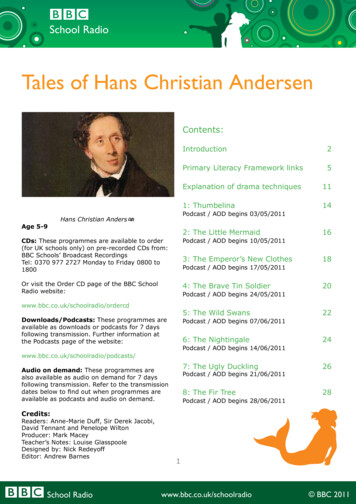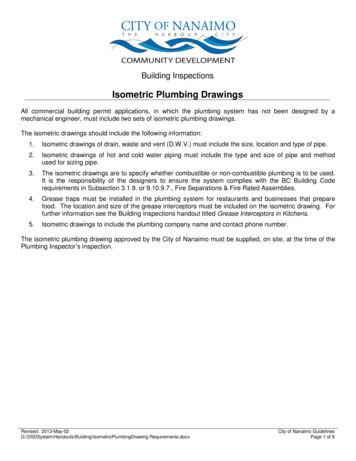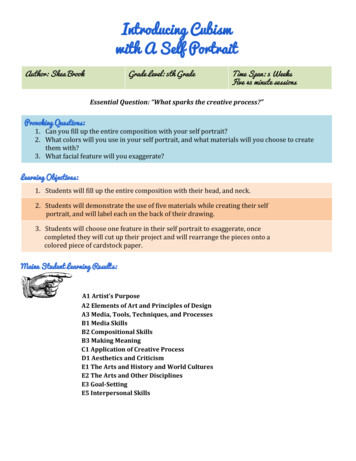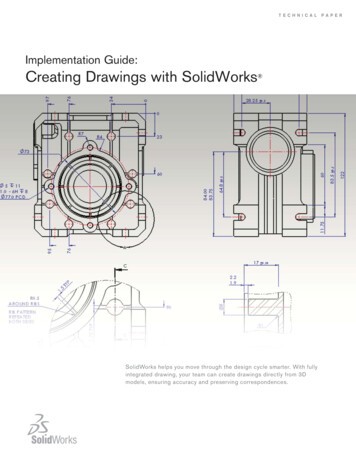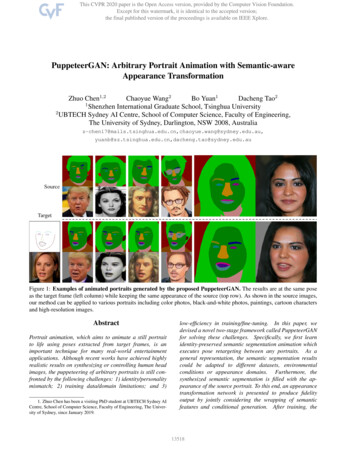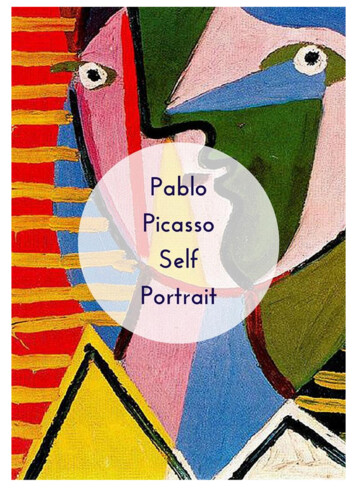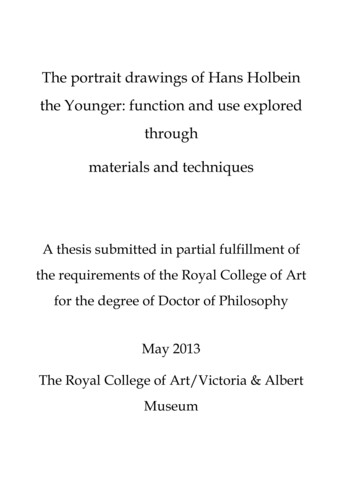
Transcription
The portrait drawings of Hans Holbeinthe Younger: function and use exploredthroughmaterials and techniquesA thesis submitted in partial fulfillment ofthe requirements of the Royal College of Artfor the degree of Doctor of PhilosophyMay 2013The Royal College of Art/Victoria & AlbertMuseum
Copyright StatementThis text represents the submission for the degree of Doctor of Philosophy at the RoyalCollege of Art. This copy has been supplied for the purpose of research for private study,on the understanding that it is copyright material, and that no quotation from the thesismay be published without proper acknowledgement.
AbstractThis thesis examines the materials and techniques of sixteenth century artist Hans Holbein theYounger, with particular reference to his portrait drawings. The research reinstates the drawingsas the primary source-material for investigation, thereby demonstrating the link between thematerials and techniques chosen by Holbein, and the function or end-use of the drawings.Although around one hundred Holbein portrait drawings survive, the focus of this research is theeighteen that relate to currently attributed oil and miniature paintings. By focusing the researchin this manner, it is possible to establish how Holbein constructed and used the drawings in thepreparation of the finished oil painting. Furthermore, it explains how his choice and use ofmaterials and techniques can help to establish the original context and function of the drawings.An important outcome of this research is a detailed description of the eighteen drawings thatrelate to a painted portrait. Having developed an effective method of examining and describingHolbein’s drawings, this research provides a thorough analysis of the materials and techniquesused by him. This not only increases our understanding of his drawing processes, but alsobroadens the limitations of traditional connoisseurship by offering a more accessible tool,allowing objective visual analysis of an artist’s technique. This method of investigation can beapplied to drawings in a wider context of sixteenth century artistic production. Moreover, it canalso be used as a potential model for how to effectively ‘read’ a drawing in order to betterunderstand its function and method of production. The results inform art historical andconservation research.A comprehensive, systematic visual examination of the drawings has helped to reveal newinformation on Holbein’s methods and materials, and offers insights into 16th century workshoppractice. In many cases examination has clarified the sequence in which the media was laid down.Holbein’s emphasis on the contours that define sitters’ features has been much disputed, and theirrole, media, and application methods were unclear. What has previously been described asmetalpoint marks were discovered by the author to be indentations, which have become filledwith loose media, thereby giving the appearance of a drawn line. The indentations actually showevidence of tracing of the salient lines that capture likeness for transfer. The research has alsorevealed that red chalk was the preliminary media for defining features, and that Holbeindeveloped standardised techniques for rendering flesh tones, making the drawing process moreefficient. It is apparent that Holbein chose techniques to fulfill a particular role, and that there areclear links between these techniques and their location on a drawing.
Table of ContentsIntroduction .1Chapter One: A Biography of Hans Holbein the Younger and History of the PortraitDrawings.91. 0 Introduction. 91.1 Hans Holbein the Younger: a brief biography. 91.2 Holbein’s portrait drawings: a brief history of their collection and location . 161.3 Holbein’s portrait drawings: history of their housing, including condition andconservation . 241.3.1 Introduction. 241.3.2 Holbein’s portrait drawings: history of their housing and mounting . 251.3.3 Condition of the drawings: historical accounts of their care and conservation . 32Chapter Two: Literature Review and Methodology .452.1 Literature Review . 452.2 Connoisseurship. 512.3 Capturing Likeness. 552.4 Optical Devices. 582.5 Materials and techniques. 602.6 Contours . 632.7 Signs of transfer. 652.8 More recent research . 672.9 Methodology . 70Chapter Three: The Materials and Techniques of Holbein’s Portrait Drawings .843.1 Introduction. 843.2 Holbein’s drawing materials . 853.3 Holbein’s papers. 873.3.1 Watermarks in Holbein’s papers. 883.3.2 Holbein’s unprepared papers . 903.4 A general overview of prepared papers. 923.4.1 Holbein’s early prepared papers . 953.4.2 Holbein’s pink prepared papers . 983.4.3 Composition and reconstruction of Holbein’s pink preparation. 983.4.4 Holbein’s portrait drawings on pink prepared paper. 1003.5 Holbein’s use of paper and parchment as a painting support .1063.6 Holbein’s drawing methods and materials .1113.6.1 Introduction. 1113.6.2 Capturing likeness . 1113.6.3 Holbein’s drawing process: a brief synopsis . 1143.6.4 Holbein’s use of metalpoint for portrait drawing . 1153.6.5 The characteristics of metalpoint . 1163.6.6 Holbein’s portrait drawings in metalpoint . 1173.6.7 The presence of metalpoint on Holbein’s pink prepared paper portraits . 1203.6.8 Erasmus’s hands: an example of Holbein’s metalpoint drawing. 1223.6.9 Chalks . 1243.6.10 A brief introduction to chalks as drawing media . 1243.6.11 Holbein’s use of chalk for portraiture. 1283.6.12 Holbein’s sitters’ eyes . 1343.6.13 A copy and an original: a comparison of techniques . 1353.6.14 Holbein’s use of aqueous media. 1363.7 Transfer techniques.141Chapter Four: The Function of Holbein’s Portrait Drawings. 1474.1 Introduction.1474.2 What is a drawing? .1484.3 Classification of drawings: history and terminology in relation to function .149
4.4 The appearance of Holbein’s portrait drawings: the relationship of materials andtechnique to function.1614.4.1 Holbein’s substrates: the significance of size to function. 1614.4.2 The function of Holbein’s papers. 1704.4.3 Holbein’s pink prepared papers . 1724.4.4 Pink prepared paper: its link to the coloured grounds of panel and miniature painting. 1784.4.5 The function of Holbein’s drawing media: the link to painting. 1834.5 Holbein’s portrait drawings as face patterns: contouring, signs of transfer and thedrawings’ relationship to the underdrawing of paintings .1944.5.1 Holbein’s portrait drawings: function of contours and signs of transfer . 1954.5.2 The function of aqueous black media on Holbein’s drawings . 1984.5.3 Signs of transfer on Holbein’s portrait drawings . 2024.5.4 Drawings and underdrawings: the relationship of one to the other. 205Conclusion. 216Appendix One: Analysis of the watermarks on Holbein’s portrait drawings . 226Appendix Two: Reconstruction of a Pink Preparation . 233Appendix Three: Dürer’s drawing apparatus and some observations following itsreconstruction and use. 236Appendix Four: Tables. 240TABLE 1: Drawing and paintings by Hans Holbein: location & inventory information fordrawings that relate to paintings of the same sitter and constitute the main body of workstudied for thesis.240TABLE 2: Size of drawings and size of paintings .242TABLE 3a: The Watermarks of Holbein’s Portrait Drawings: By Type .243TABLE 3b: The watermarks on Holbein’s drawings: by date .252TABLE 4: Survey of Signs of Transfer on Hans Holbein’s Portrait Drawings.258TABLE 5: Signs of transfer ( * prepared papers).265Table 6: Drawing information.268Table 7: Jacob Meyer zum Hasen (Figure 1) .274Table 8: Dorothea Kannengiesser (Figure 2) .276Table 9: Jacob Meyer zum Hasen (Figure 4) .278Table 10: Dorothea Kannengiesser (Figure 5).279Table 11: Anna Meyer (Figure 6) .280Table 12: Sir Thomas More (Figure 8) .282Table 13: William Warham, Archbishop of Canterbury (Figure 10) .284Table 14: Sir Henry Guildford (Figure 12).286Table 15: Lady Mary Guildford (Figure 14).287Table 16: William Reskimer (Figure 16).288Table 17: Charles de Solier, Sieur de Morette (Figure 18) .290Table 18: Unknown Gentleman (Figure 20).292Table 19: Simon George of Quocote (Figure 22).294Table 20: Sir Richard Southwell (Figure 24) .296Table 21: Jane Seymour (Figure 26) .298Table 22: Lady Elizabeth Audley (Figure 28) .300Table 23: Edward, Prince of Wales (Figure 30) .302Bibliography. 303
In Volume II: Images to accompany the textList of FiguresFigure 1: Jacob Meyer zum Hasen, 1516. Hans Holbein the Younger. Basel Kunstmuseum,Kupferstichkabinett. Inv. No: 1823.137Figure 2: Dorothea Kannengiesser 1516. Hans Holbein the Younger, Basel Kunstmuseum,Kupferstichkabinett. Inv. No: 1823.137aFigure 2.1: detailFigure 3: Double Portrait of Jacob Meyer zum Hasen & Dorothea Kannengiesser, 1516.Hans Holbein the Younger. Painting. Basel, Kunstmuseum. Oil on panel. Inv. No: 312Figure 4: Jacob Meyer, c.1526. Hans Holbein the Younger. Basel Kunstmuseum,Kupferstichkabinett. Inv. No: 1823.140Figure 4.1: detailFigure 4.2: detailFigure 4.3: detailFigure 4.4: detailFigure 4.5: detailFigure 4.6: detailFigure 5: Dorothea Kannengiesser, c.1526. Hans Holbein the Younger, BaselKunstmuseum, Kupferstichkabinett. Inv. No: 1823.141Figure 5.1: detail
Figure 5.2: detailFigure 5.3: detailFigure 6: Anna Meyer, c.1526. Hans Holbein the Younger. Basel Kunstmuseum,Kupferstichkabinett. Inv. No: 1823.142Figure 6.1: detailFigure 6.2: detailFigure 7: Darmstadt Madonna ,1526-1528. Hans Holbein the Younger. Formerly ondisplay at the Städel Museum as a loan, Frankfurt. Oil on panel.Figure 7.1: detailFigure 8: Sir Thomas More, 1527. Hans Holbein the Younger. The Royal Collection, TheRoyal Library, Windsor. Inv. No: RL12268Figure 8.1: detailFigure 8.2: detailFigure 8.3: detailFigure 9: Sir Thomas More, 1527. Hans Holbein the Younger. The Frick Collection. Oil onpanel. Inv. No: 1921.1.77Figure 9.1: detail
Figure 10: William Warham, Archbishop of Canterbury, 1527. Hans Holbein the Younger.The Royal Collection, The Royal Library, Windsor. Inv. No: RL12272Figure 10.1: detailFigure 10.2: detailFigure 10.3: detailFigure 10.4: detailFigure 10.5: detailFigure 11: William Warham, 1527, Hans Holbein the Younger. Musée du Louvre, Paris.Oil on panel. Inv. No: 1344Figure 12: Sir Henry Guildford, 1527, The Royal Collection, The Royal Library, WindsorCastle. Inv. No: RL12266Figure 13: Sir Henry Guildford, 1527. The Royal Collection, Windsor Castle. Oil on panel.Inv. No: RCIN.400046Figure.14: Lady Mary Guildford, 1527 Basel Kunstmuseum, Kupferstichkabinett. Inv. No:1662.35Figure 14.1: detailFigure 15: Lady Mary Guildford, 1527. Hans Holbein the Younger. Saint Louis ArtMuseum. Oil on panel. Inv. No: 1:1943
Figure 16: William Reskimer, c.1533. Hans Holbein the Younger. The Royal Collection,The Royal Library, Windsor Castle. Inv. No: RL12237Figure 17: William Reskimer, c.1533, Hans Holbein the Younger. The Royal Collection,Hampton Court. Oil on panel. Inv. No: RCIN.404422Figure 18: Charles de Solier, Sieur de Morette, 1534/35. Hans Holbein the Younger.Staaliche Kunstsammlungen, Kupferstichkabinett, Dresden. Inv. No: C1977-156Figure 18.1: detailFigure 18.2: detailFigure 18.3: detailFigure 18.4: detailFigure 18.5: detailFigure 18.6: detailFigure 19: Charles de Solier, Sieur de Morette, 1534/35. Hans Holbein the Younger.Staaliche Kunstsammlungen, Gemäldegalerie Alte Meister, Dresden. Oil on panel. Inv.No: 1890Figure 19.1: detailFigure 20: Unknown Gentleman, (Parker 33), 1535. Hans Holbein the Younger. The RoyalCollection, The Royal Library, Windsor Castle. Inv. No: RL12259Figure 20.1: detail
Figure 20.2: detailFigure 20.3: detailFigure 20.4: detailFigure 20.5: melinex tracing of drawing mapping indented contoursFigure 21: Unknown Gentleman, 1535. After Hans Holbein the Younger. TheMetropolitan Museum of Art, New York. Oil on panel. Inv. No: 49.7.28Figure 21.1Figure 21.2Figure 21.3Figure 22: Simon George, c.1535. Hans Holbein the Younger. The Royal Collection, TheRoyal Library, Windsor Castle. Inv. No: 12208Figure 22.1: detailFigure 22.2: detailFigure 22.3: melinex tracing of drawing mapping indented contoursFigure 23: Simon George, c.1535. Hans Holbein the Younger. Städelsches Kunstintitut,Frankfurt. Oil on panel. Inv. No: 1065Figure 23.1: detail, underdrawing showing pouncing of handFigure 23.2: detail, melinex tracing of drawing over paintingFigure 24: Richard Southwell, 1536. The Royal Collection, The Royal Library, WindsorCastle. Inv. No: RL12242
Figure 24.1: detailFigure 24.2: detailFigure 24.3 melinex tracing of drawing mapping indented contoursFigure 25: Richard Southwell, 1536. Hans Holbein the Younger. Galleria degli Uffizi,Florence. Oil on panel. Inv. No: 765Figure 26: Jane Seymour, c.1536/37. Hans Holbein the Younger The Royal Collection, TheRoyal Library, Windsor Castle. Inv. No: RL12267Figure 26.1: detailFigure 26.2: detailFigure 26.3: detailFigure 26.4: detailFigure 26.5: detailFigure 27: Jane Seymour, c.1536/37. Hans Holbein the Younger. KunsthistorischesMuseum, Vienna, Gemäldegalerie. Oil on panel. Inv. No: 881Figure 28: Lady Audley, c.1538. Hans Holbein the Younger. The Royal Collection,Windsor Castle. Inv. No: RL12191Figure 28.1: detailFigure 28.2: detail, infra red imageFigure 28.3: detail, together with Figure 29.2 (detail of miniature)
Figure 29: Lady Audley, c.1538. Hans Holbein the Younger. The Royal Collection, WindsorCastle. Miniature. Inv. No: RCIN 422292Figure: 29.1: detail showing overlaying of scaled down drawing on to miniature (image:Nick Frayling)Figure 29.2: detail, see Figure 28.3Figure 30: Edward, Prince of Wales, c.1538. Hans Holbein the Younger. The RoyalCollection, The Royal Library, Windsor Castle. Inv. No: RL12200Figure 30.1: detailFigure 31: Edward, Prince of Wales, c.1538. Hans Holbein the Younger. National Galleryof Art, Washington DC, Andrew W Mellon Collection. Oil on panel. Inv. No: 1937.1.64Figure 32: Lady Margaret Butts, c.1540/43. Hans Holbein the Younger. The RoyalCollection, The Royal Library, Windsor Castle. Inv. No: RL12264Figure 32.1: detailFigure 32.2: melinex tracing of drawing mapping indented contoursFigure 33: Lady Margaret Butts, c.1540/43. Hans Holbein the Younger. Isabella StewartGardner Museum, Washington. Oil on panel. Inv. No: P21e5
Figure 34: John Godsalve, c.1532-34. Hans Holbein the Younger. The Royal Collection, TheRoyal Library, Windsor Castle. Inv. No: RL12265Figure 34.1: detailFigure 34.2: detailFigure 35: A Boy with Marmoset, c.1532-36. Hans Holbein the Younger. KunstmuseumBasel, Kupferstichkabinett. Inv. No: 1823.139Figure 36: Lady Elyot, c.1532-34. Hans Holbein the Younger. The Royal Collection, TheRoyal Library, Windsor Castle. Inv. no: RL12004Figure 36.1: detail, together on same page as Figure 36Figure 37: Portrait of a Young Man, 1517. Ambrosius Holbein. Kunstmuseum Basel,Kupferstichkabinett. Inv. No: 1662.207aFigure 37.1: detail, on same page as Figure 37Figure 38: Sir Thomas More, (Parker 2), 1527. Hans Holbein the Younger. The RoyalCollection, The Royal Library, Windsor Castle. Inv. No: RL12225Figure 38.1: detailFigure 38.2: detail showing melinex tracing of Parker 2 laid over painting
Figure 39: Lady Ratcliffe, 1532-43, Hans Holbein the Younger. The Royal Collection, TheRoyal Library, Windsor Castle. Inv. No: RL12236Figure 39.1: detail, infra-red imageFigure 40: Nicholas Carew, 1527. Hans Holbein the Younger. Basel Kunstmuseum,Kupferstichkabinett. Inv. No: 1662.34Figure 41: Studies of Hands, c.1502. Hans Holbein the Elder. Basel Kunstmuseum,Kupferstichkabinett. Inv. No: 1662.195Figure 42: Portrait of a Young Boy, 1516. Ambrosius Holbein. Basel, Kunstmuseum,Kuperfstichkabinett. Inv. No: 1921.44Figure 43: Portrait of an English Nobleman. c.1527. Hans Holbein the Younger. Basel,Kunstmuseum, Kupferstichkabinett. Inv. No: 1662.122Figure 44: Portrait of an English Noblewoman. c.1527. Hans Holbein the Younger. Basel,Kunstmuseum, Kupferstichkabinett. Inv. No: 1662.123
Figure 45: Jean de France, Duke of Berry, 1524. Hans Holbein the Younger. BaselKunstmuseum, Kupferstichkabinett. Inv. No: 1662.125Figure 46: Jeanne de Boulogne, Duchess of Berry, 1524. Hans Holbein the Younger. BaselKunstmuseum, Kupferstichkabinett. Inv. No: 1662.126Figure 47: Jan van Eyck, Portrait of a Cardinal (?Niccolò Albergati), c.1435.Kupferstichkabinett, Staaliche Kunstsammlungen, Dresden. Inv. No: C775Figure 47.1: detailFigure 48: Portrait of Anne,1518. Hans Holbein the Elder. Basel Kunstmuseum,Kupferstichkabinett. Inv. No: 1662.207Figure 49: Self Portrait, c.1502. Hans Baldung Grien. Basel Kunstmuseum,Kupferstichkabinett. Inv. No: U.VI.36Figure 50: Design for a pendant set with ruby, sapphires and pearls, c.1532. Hans Holbeinthe Younger. The British Museum, London. SL,5308.107
Figure 51: Portrait of a Member of the Wedigh Family, probably Hermann Wedigh, 1532.Hans Holbein the Younger. The Metropolitan Museum of Art, New York. Oil on panel.Inv. No: 50.135.4Figure 51.1: detailFigure 51.2: detailFigure 52: Benedict von Hertenstein, 1517. Hans Holbein the Younger. MetropolitanMuseum of Art, New York. Oil on paper on panel. Inv. No: 06.1038Figure 53: The More Family Group, 1527. Hans Holbein the Younger. BaselKunstmuseum, Kupferstichkabinett. Inv. No: 1662.31Figure 54: Drawing Apparatus, 1525. Albrecht Dürer. The British Museum, London. Inv.No: 1895,0122.730Figure 55: reproduction of the drawing apparatus in useFigure 56: detail of the drawing of Charles de Solier, Figure 18, illustrating the felt side ofthe paperFigure 57: detail of the drawing of An English Nobleman, Figure 43, illustrating the wireside of the paper
Figure 58: Portrait of a Man in a Hat, 1518. Hans Holbein the Elder. Basel Kunstmuseum,Kupferstichkabinett. Inv. No: 1662.186Figure 58.1: detailFigure 59: Portrait of Sigmund Holbein, 1512. Hans Holbein the Elder. The BritishMuseum, London. Inv. No: 1895,0915.987Figure 60: Bildnis des Zimprecht Schwarz, c.1508. Hans Holbein the Elder. BaselKunstmuseum, Kupferstichkabinett. Inv. 1662.190Figure 60.1: detailFigure 61: Portrait of a Young Boy Looking Down, Hans Holbein the Elder. BaselKunstmuseum, Kupferstichkabinett. Inv. 1662.192Figure 62: pink preparation reconstruction showing difference on dryingFigure 62.1: painting out the pink preparation during reconstruction showing cocklingpaper
Figure 63: Portrait of a Young Lady, 1520/22. Hans Holbein the Younger. Musée duLouvre, Cabinet des Dessins, Paris. Inv. No: 20.737Figure 64: Head of a Woman, c.1540. Cornelius van Cleef. The Royal Collection, The RoyalLibrary, Windsor Castle. Inv. No: RL12955Figure 65: Portrait of a Man Wearing a Hat, c.1510/15. Lucas Cranach the Elder. TheBritish Museum, London. Inv. No: 1896,0511.1Figure 66: photograph illustrating laying out of Holbein drawings in The Royal LibraryFigure 67: Two Studies of the Left Hand of Erasmus of Rotterdam; Study of the RightHand Writing, c.1523. Hans Holbein the Younger. Museé du Louvre, Cabinet des Dessins.Inv. No: 18697Figure 67.1: detailFigure 67.2: detailFigure 67.3: detailFigure 68: Study of the Right Hand of Erasmus of Rotterdam and Portrait Study, c.1523.Hans Holbein the Younger. Museé du Louvre, Cabinet des Dessins. Inv. No: 18698
Figure 68: detailFigure 69: photograph, use of raw sienna chalkFigure 70: Bust Portrait of a Young Woman, 1518. Niklaus Manuel Deutsch. BaselKunstmuseum, Kupferstichkabinett. Inv. No: U.X.10Figure 71: Portrait of a Man Wearing a Fur Lined Coat and Broad Rimmed Hat, 1522. WolfHuber. Kupferstichkabinett, Städel Museum, Frankfurt. Inv. No: 16336Figure 72: Cecily Heron, 1527. Hans Holbein the Younger. The Royal Collection, TheRoyal Library, Windsor Castle. Inv. No: RL12269Figure 73: Sir Thomas Wyatt, c.1535-37. Hans Holbein the Younger. The Royal Collection,The Royal Library, Windsor Castle. Inv. No: RL12250Figure 73.1: detailFigure 73.2: detail
Figure 74 Sir Thomas Wyatt – copy. c.1535-37. (Parker 65) Anon. The Royal Collection, TheRoyal Library, Windsor Castle. Inv. No: RL12251Figure 74.1: detailFigure 74.2: detailFigure 75: Portrait of Guillaume de Saulx, Sieur de Tavannes, c.1529-40. Jean Clouet. TheBritish Museum, London. Inv. No: 1910,0212.54Figure 75.1: detailFigure 76: Elizabeth, Lady Vaux, c.1536. Hans Holbein the Younger. The Royal Collection,The Royal Library, Windsor Castle. Inv. No: RL12247Figure 77: reconstruction of the carbon paper transfer technique with charcoalFigure 78: reconstruction of the carbon paper transfer technique with black chalkFigure 79: reconstruction of the carbon paper transfer technique with red chalkFigure 80: photograph of all three techniques and reconstruction of a Holbein portraitFigure 81: The Leoni Album binding.: The Royal Collection, The Royal Library, WindsorCastle.Figure 81.1: The Leoni Album binding, interior. The Royal Collection, The Royal Library,Windsor Castle.
Figure 82: Cecily Heron and Lady Audley, a comparison of unprepared and pinkprepared paper. The Royal Collection, The Royal Library, Windsor Castle.Figure 83: historic mount example with red wash lines, The Royal Collection, The RoyalLibrary, Windsor Castle.Figure 83.1: detail
The portrait drawings of Hans Holbein the Younger: function and use explored through materials and techniques . This not only increases our understanding of his drawing processes, but also broadens the limitations of tradit
